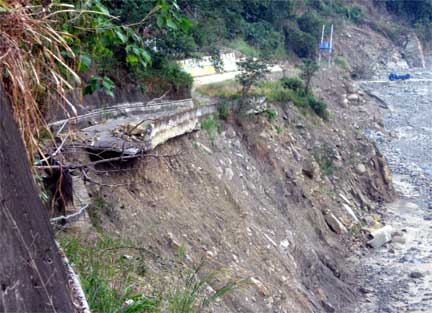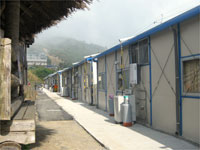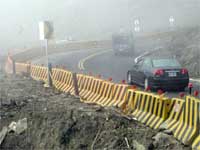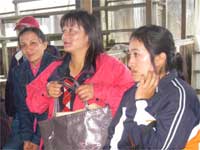Taiwan - climate change
What Typhoon Morakot left behind
by Rosslyn Hyams
Article published on the 2009-12-01 Latest update 2010-01-05 15:52 TU
It’s the dry season, but the vegetation cover is still lush on mountain slopes of southern Taiwan. Except, that is, for the vertical swathes of grey in between the green.
These are rocky scars of mud and landslides caused by the heavy rains and subsequent floods brought by Typhoon Morakot. The area received close the usual annual rainfall in just three days in August 2009.
Riverbeds have become wider, and most of the bridges that straddled the rivers and streams in the highland areas of Chiayi County have disappeared.
“We have to learn to live with nature better,” says Chern Jenn-chuan, deputy CEO of the government’s Morakot Post-Disaster Reconstruction Council (MDRC), who has a lot on his plate.
An engineer, Chern leads a team whose tasks stretch from clearing debris to re-building electricity, telecoms and roads, to overseeing economic recovery and resettling several thousand displaced people. They have some 120 billion NT$ (2.4 billion euros) to do it with.
Feature: Taiwan recovering from Typhoon Morakot - 1 of 2
The MDRC has identified 42 safe sites where people could make their new lives.
Chern shows a development being built by the Buddhist Tzuchi Foundation and a private firm, Hon Hai Group, on land that used to be used to grow sugarcane. It will become an ecological estate, including a new organic farming area, for those who lost their homes, and for indigenous people in Yuehmei, Kaohsiung County.
Taiwan has 14 indigenous tribes, and three months after the typhoon hit, some 17,000 indigenous peoples in the mountain region are still living in temporary housing.
In the Alishan Shizhou area about 72 prefabricated houses sent by China stand in several rows on the site of an indigenous tourism centre. Some families of the Tzou tribe are living there.
Their leaders are negotiating with the government to find solutions. While they seem upbeat, the short term perspectives look challenging.
Tourism, a main source of income, has dried up. The other source of income, agriculture, was severely damaged or wiped out. The government has paid out compensation and is employing some people to help clear and rebuild infrastructure and permanent housing.
There is hope that before the Chinese New Year in February new homes and a new tourist trade will be operational.
Some Tzou families from Shanmei village run a hotel which is still standing, perched on the rocks with a magnificent view of the valley. From there you can see the main road which used to bring tourists.
You can also see that the bridge to facilities on the other side of the valley is gone.
Despite government compensation, the owners of the hotel fear the loss of yet another season if they remain cut off.
Chern of the MDRC is greeted by two demonstrations near what was the village of Xiaolin, which was wiped out, with all 400 residents. Here, about 1,000 people from the Bunong tribe are living in a military camp.
Chern was heckled by a woman from the Southern Tribe Alliance for Reconstruction, who are up in arms over the government’s plans for them. They say they are being forced into quitting their ancestral lands, and they accuse the government of wanting to take it over.
People desperately want to stay on their land, as they farm for a living.
The government says it is only thinking about safety.
“We cannot rebuild the road that went around the mountain through this valley,” says Chern. “It is too long, too costly and there is not enough time before the next rainy season, so these people would be cut off. It is dangerous for them to return here.”














